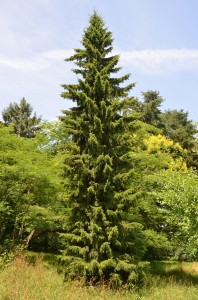Serbian spruce (Picea omorika) rises as a tall spire in the urban landscape. A mature tree may reach 50 to 60 feet high and it creates a narrow footprint of 15 to 25 feet wide. Lateral branches uniquely bend downward while the growing tips sweep gracefully upward.
Annual growth rate is slow at 12-15 inches. Two-thirds of the short dark green needles lay flat. Needles are lustrous on the upper surface with two prominent white bands on the underside. Oval-shaped 2 ½ inches long cones hang downward, bluish-black early and light cinnamon at maturity.
Serbian spruce is highly adaptable. It grows well in full or partial sunlight (6 hours recommended) and rooted in moist well-drained soils with a wide pH range. A 3-year and older established tree handles summer dry spells and rough urban environs. A nursery-grown tree transplants well in the early fall or late winter periods from container or balled and burlapped (B&B) stock. It is northern hardy to USDA hardiness zone 4 and with good heat tolerance to zone 7-a. It becomes heat challenged past this point.
Serbian spruce deserves a more prominent place in commercial and residential landscapes. Few diseases and pests trouble this staturesque tree. You can group several together as a windbreak or privacy screen or plant a single specimen, where ground space may not be plentiful.
If you are searching for an alternative to the oft-used Norway and Colorado spruces, try Serbian spruce. Dwarf and weeping cultivars are also available through e-commerce specialty conifer nurseries on-line.


 Posted in
Posted in 
